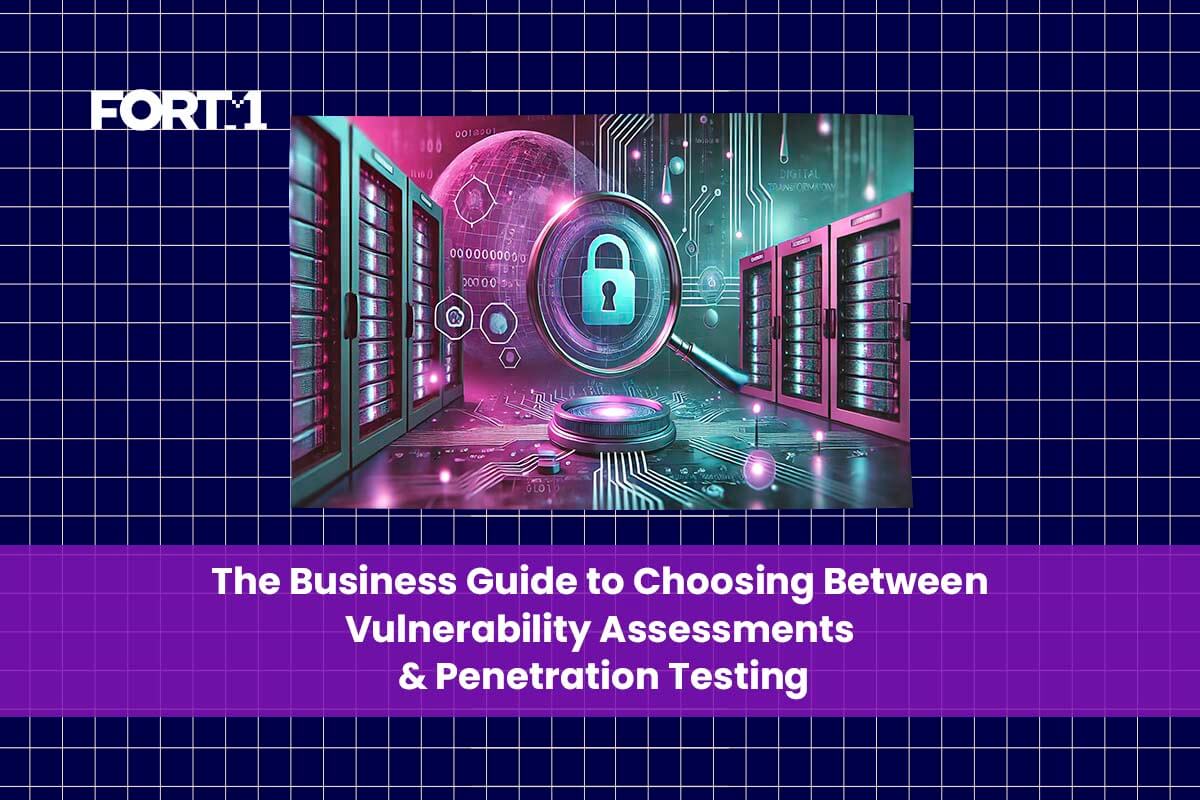




Cybersecurity breaches have surged in recent years, with Australia recording a 26% increase in cybercrime reports in 2023, according to the Australian Cyber Security Centre (ACSC). The financial and reputational consequences of security incidents make it essential for businesses to adopt proactive security measures. However, determining the right security testing approach can be challenging, particularly when choosing between Vulnerability Assessments (VA) and Penetration Testing (PT).
A Vulnerability Assessment is a systematic process that identifies and prioritises known security weaknesses within an organisation’s IT infrastructure. This method relies on automated tools to scan networks, applications, and systems for vulnerabilities that could be exploited by attackers. It is often used for continuous monitoring and compliance with industry regulations.
In contrast, Penetration Testing is a controlled simulation of a cyberattack performed by ethical hackers to uncover security gaps that automated scans may miss. Unlike a vulnerability assessment, penetration testing provides insights into how an attacker could exploit vulnerabilities and the potential business impact.
Selecting between VA and PT depends on various factors, including business size, industry, compliance obligations, and budget. Organisations governed by ISO 27001 or PCI-DSS may require both approaches to meet regulatory requirements. A clear understanding of these methodologies enables businesses to make informed decisions, strengthening their overall cybersecurity posture.
A Vulnerability Assessment (VA) is a structured process that identifies and evaluates security weaknesses within an organisation’s IT environment. Unlike Penetration Testing (PT), which actively exploits vulnerabilities to assess real-world risks, a VA focuses on detecting and prioritising known security flaws before they can be exploited.
Vulnerability assessments employ automated scanning tools to inspect networks, applications, and systems for outdated software, misconfigurations, and exposed assets. This process enables security teams to assess risk levels and take corrective action before attackers can leverage these weaknesses. According to the Australian Cyber Security Centre (ACSC), over 90% of cyber incidents could be prevented by addressing known vulnerabilities through proactive assessments.
VA is particularly beneficial for businesses that:
✔ Require ongoing compliance checks (e.g., financial institutions, healthcare providers).
✔ Operate large, complex networks with evolving security requirements.
✔ Need a cost-effective way to monitor security posture over time.

Penetration Testing (PT) is an advanced cybersecurity assessment that simulates real-world attacks to evaluate the resilience of an organisation’s security controls. Unlike Vulnerability Assessments (VA), which identify known weaknesses, penetration testing actively exploits vulnerabilities to determine their impact and test defensive mechanisms. This method is particularly valuable for identifying zero-day vulnerabilities and complex attack chains that automated scans may overlook.
Penetration testing can be conducted using:
✔ Automated tools to identify common weaknesses efficiently.
✔ Manual testing by ethical hackers to simulate sophisticated cyber threats.
Automated scans provide speed and coverage, but they often fail to detect business logic flaws, misconfigurations, and chained exploits. Ethical hackers use frameworks like the MITRE ATT&CK matrix to replicate the techniques used by real attackers, ensuring a comprehensive security evaluation.
A penetration test follows structured methodologies, such as OWASP’s Web Security Testing Guide and NIST SP 800-115, to mimic adversarial techniques. The testing process typically involves:
Penetration testing is essential for organisations that:
✔ Operate in high-security industries, such as finance, healthcare, and government.
✔ Need to comply with PCI-DSS, ISO 27001, GDPR, and APRA CPS 234.
✔ Deploy customer-facing applications that handle sensitive data.
✔ Require red teaming exercises to evaluate incident response capabilities.
| Key Factor | Vulnerability Assessment (VA) | Penetration Testing (PT) |
|---|---|---|
| Automation vs. Manual Testing | Primarily automated | Manual with automated support |
| Scope of Security Evaluation | Identifies known vulnerabilities | Simulates real-world attack scenarios |
| Frequency | Regular (weekly/monthly) | Periodic (annually or biannually) |
| Cost | Lower due to automation | Higher due to manual testing effort |
| Compliance Needs | Supports ongoing compliance monitoring | Often a compliance requirement for high-risk industries |
Businesses must choose the appropriate security evaluation method based on risk tolerance, regulatory obligations, and resource availability. While Vulnerability Assessments (VA) and Penetration Testing (PT) both serve critical roles in cybersecurity, they differ significantly in depth, cost, time commitment, and compliance relevance.
A Vulnerability Assessment identifies known security weaknesses using automated scanning tools but does not actively exploit them. In contrast, Penetration Testing simulates real-world attack scenarios, providing a deeper understanding of how vulnerabilities could be exploited by adversaries.
VA is generally more cost-effective since it relies on automated scans and can be conducted frequently. PT, however, involves manual testing by security experts, making it more resource-intensive and expensive.
Industries with strict cybersecurity regulations, such as finance, healthcare, and critical infrastructure, often require penetration testing for compliance with PCI-DSS, ISO 27001, GDPR, and APRA CPS 234. VAs, while beneficial, may not be sufficient for meeting all regulatory requirements.
Industries with strict cybersecurity regulations, such as finance, healthcare, and critical infrastructure, often require penetration testing for compliance with PCI-DSS, ISO 27001, GDPR, and APRA CPS 234. VAs, while beneficial, may not be sufficient for meeting all regulatory requirements.
Below is a side-by-side comparison highlighting the advantages and limitations of each approach:
| Aspect | Vulnerability Assessment (VA) | Penetration Testing (PT) |
|---|---|---|
| Depth of Security Analysis | Identifies known vulnerabilities but does not exploit them | Simulates real-world attacks to assess actual risks |
| Cost | Lower cost due to automation | Higher cost due to manual testing and expertise |
| Time & Resources | Fast and efficient; requires minimal resources | Time-intensive and requires skilled security professionals |
| Compliance Needs | Useful for maintaining compliance but may not meet all regulatory requirements | Often required for compliance with industry standards |
| Frequency | Conducted regularly (weekly/monthly) | Performed periodically (annually or biannually) |
| Pros | Cost-effective, quick, suitable for ongoing security monitoring | Identifies complex attack scenarios, required for compliance |
| Cons | Does not confirm exploitability, may produce false positives | Expensive, time-consuming, and requires skilled personnel |
By understanding these key differences, businesses can align their cybersecurity strategies with risk management objectives and regulatory obligations.
Selecting between Vulnerability Assessments (VA) and Penetration Testing (PT) requires a clear understanding of an organisation’s security priorities, industry regulations, and resource availability. The decision should be based on business size, risk exposure, and compliance obligations.
✔ Managed VA is ideal for businesses that need continuous security visibility but lack the resources for intensive testing.
✔ PT is essential for organisations requiring compliance validation and real-world attack simulation.
✔ Combining VA and PT enhances security by addressing both known and unknown vulnerabilities.
The flowchart below helps businesses determine whether VA, PT, or a combination is most suitable for their security needs.
Businesses requiring PCI-DSS compliance must conduct annual PT to protect cardholder data. A case study on how financial institutions meet security standards using PT is available in the PCI-DSS documentation:
https://www.pcisecuritystandards.org/.
By evaluating these factors, businesses can strategically integrate VA and PT to strengthen their cyber resilience while meeting regulatory and operational requirements.
Cybersecurity requirements differ across industries, with each sector facing unique security threats and compliance obligations. The following real-world case studies demonstrate how businesses utilise Vulnerability Assessments (VA) and Penetration Testing (PT) to protect their digital assets, maintain regulatory compliance, and mitigate cyber risks.
A national retail chain handling customer payment information must comply with the Payment Card Industry Data Security Standard (PCI-DSS). To achieve compliance, the business implements a continuous VA program to detect vulnerabilities in its point-of-sale (POS) systems and e-commerce platform. The automated scans help identify outdated software, misconfigurations, and potential attack vectors before they can be exploited.
✔ Outcome: Improved security posture and PCI-DSS compliance through regular VA reporting.
A fintech startup offering online banking services requires penetration testing to assess the security of its customer-facing web applications. The company engages ethical hackers to simulate SQL injection, authentication bypass, and privilege escalation attacks. This approach uncovers critical security flaws that automated scans fail to detect.
✔ Outcome: Strengthened application security, ensuring that customer transactions remain secure from sophisticated attacks.
A large hospital network managing electronic health records (EHRs) faces strict data protection regulations under ISO 27001 and the Australian Privacy Act. To safeguard patient data, the organisation adopts a layered security approach:
✔ Outcome: Achieved comprehensive risk management, ensuring both compliance and resilience against cyber threats.
Below is a comparison table highlighting how different industries apply VA and PT to achieve cybersecurity objectives.
| Industry | Security Goals | Testing Approach Used |
|---|---|---|
| Retail (PCI-DSS Compliance) | Ensure secure payment transactions and meet compliance standards | Vulnerability Assessment (VA) |
| Fintech (Web Application Security) | Protect customer banking data from cyber threats | Penetration Testing (PT) |
| Healthcare (Patient Data Protection) | Secure electronic health records and comply with data protection laws | VA + PT (Layered Approach) |
By leveraging industry-specific cybersecurity strategies, businesses can enhance resilience, ensure compliance, and mitigate risks effectively.

Selecting the right security assessment approach is a critical decision for businesses aiming to reduce cyber risks and meet compliance obligations. Vulnerability Assessments (VA) offer a cost-effective, continuous security monitoring solution, making them suitable for organisations requiring regular oversight of known weaknesses. In contrast, Penetration Testing (PT) provides in-depth insights into exploitable vulnerabilities, helping businesses validate security controls against real-world attack scenarios.
For organisations handling sensitive financial transactions, healthcare records, or critical infrastructure, adopting a hybrid approach—integrating both VA and PT—ensures a comprehensive defence strategy. Regular vulnerability assessments help detect weaknesses early, while periodic penetration testing validates security effectiveness by simulating real-world attack tactics.
✔ Implement VA for routine security monitoring and compliance maintenance.
✔ Conduct PT at least annually to identify and address sophisticated threats.
✔ Align cybersecurity efforts with industry frameworks like ISO 27001, PCI-DSS, and the ACSC Essential Eight.
By leveraging structured security testing, businesses can strengthen their cyber resilience and protect critical systems from emerging threats.
🔹 Assess your cybersecurity posture today!
📞 Contact Fort1 for a consultation and let us help you secure your business against cyber threats.
👉 Visit Fort1 to learn more about our cybersecurity solutions.

Fort1 provides comprehensive cybersecurity solutions tailored to protect your business from evolving digital threats. With expertise in penetration testing, dark web monitoring, and managed detection services, we empower organisations to stay secure and resilient in the face of modern cyber challenges.
Copyright @2024 Fort1. All Rights Reserved by Fort1.